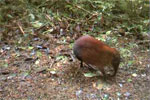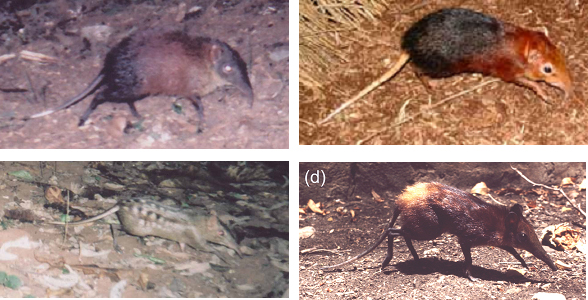New Elephant-Shrew Discovered
Posted by: Loren Coleman on September 16th, 2010

Dr. Galen Rathbun holds the grey-faced sengi, a recently discovered elephant-shrew much like the new one just found. Photo by David Ribble.
A giant elephant-shrew has been caught on camera in a remote African forest, which may be a new species, scientists say. In general, these are termed giant sengi. The unique and intriguing mammal, which has a long, flexible, trunk-like nose, was discovered in the Boni-Dodori forest in northeastern Kenya.
Camera traps were set up in the remote forest after Grace Wambui, a fellow of the Zoological Society of London’s Edge of Existence program spotted an elusive elephant-shrew she did not recognize.

This is an example from a similar camcorder trap video sequence of a gray-faced sengi foraging on a game trail through the Ndundulu Forest, Udzungwa Mountains, Tanzania. Video: Trevor Jones, 4 June 2006, 1207 hours
Sometimes, a bit of comedy develops from how this news has been delivered, in a rush to put too much info in a headline. For example, the Kenya Broadcasting Corporation has posted a story entitled, “Unknown elephant relative photographed in Kenya.” Elephant-shrews, indeed, are more closely related to elephants than shrews, despite their small size, but are named for their long trunk-like snout. All elephant-shrews are found only in Africa.

Representatives of the four species of giant sengi: (a) gray-faced sengi (camera trap image), (b) black-and-rufous sengi (captive), (c) checkered sengi (camera trap image), and (d) golden-rumped sengi (captive).
Plate from Rovero, F. & G.B. Rathbun. 2006. “A potentially new giant sengi (elephant-shrew) from the Udzungwa Mountains, Tanzania.” Journal of East African Natural History 95:111-115.
About Loren Coleman
Loren Coleman is one of the world’s leading cryptozoologists, some say “the” leading living cryptozoologist. Certainly, he is acknowledged as the current living American researcher and writer who has most popularized cryptozoology in the late 20th and early 21st centuries.
Starting his fieldwork and investigations in 1960, after traveling and trekking extensively in pursuit of cryptozoological mysteries, Coleman began writing to share his experiences in 1969. An honorary member of Ivan T. Sanderson’s Society for the Investigation of the Unexplained in the 1970s, Coleman has been bestowed with similar honorary memberships of the North Idaho College Cryptozoology Club in 1983, and in subsequent years, that of the British Columbia Scientific Cryptozoology Club, CryptoSafari International, and other international organizations. He was also a Life Member and Benefactor of the International Society of Cryptozoology (now-defunct).
Loren Coleman’s daily blog, as a member of the Cryptomundo Team, served as an ongoing avenue of communication for the ever-growing body of cryptozoo news from 2005 through 2013. He returned as an infrequent contributor beginning Halloween week of 2015.
Coleman is the founder in 2003, and current director of the International Cryptozoology Museum in Portland, Maine.










And does it answer to the name “Kate?”
Interesting news! Compared to many other mammals, some elephant-shrews are colorful, they might have to be constantly wary of predators or maybe they are toxic to them. Otherwise they looks somewhat like real-life pokémon.
Shrews are the most vicious animals on the planet, Krimeg…they’re killers, I tell you…
HAHAHAHA It looks as if the movie staff have revived a stuffed dog!